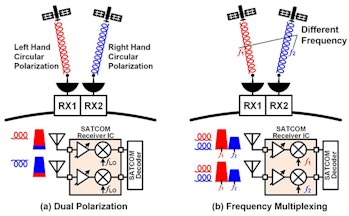
SOME OF THE BIGGEST COMPANIES IN THE WORLD, like Amazon and SpaceX, are looking towards space for the future of the Internet. Satellite-based Internet is a nascent enterprise, but analysts believe that broadband Internet beamed to Earth from orbit could be a massive business fewer than 20 years, earning hundreds of billions of dollars.
Attention has focused on the “space” part of “space Internet,” with news stories focused on the rocket launches getting SpaceX’s Starlink satellites into space, and how Amazon plans to catch up with satellites of its own. But all of these satellites will need transceivers on Earth to send and receive data. Scientists at the Tokyo Institute of Technology and Socionext Inc. have built a new one that is made to work with the next generation of Internet satellites.
WHAT ARE TRANSCEIVERS?
Unassuming pieces of tech, they are some of the least-flashy, but most important, components in history. A transceiver is a device that can both transmit and receive signals, hence the name. Combining a transmitter and a receiver into one device allows for greater flexibility and since their development in the 1920s, they’ve been used to reach remote locations. One the earliest transceivers, invented by the Australian John Traeger, was used to help doctors reach remote villages.
THE NEW TRANSCEIVER
The new transceiver, designed for space internet technology, was developed at Kenichi Okada’s lab at Tokyo Tech and presented this month at the virtual IEEE Radio Frequency Integrated Circuits Symposium, the new device has a number of improvements on both the transmitting and receiving ends of the business. All of these developments are geared toward providing Internet access in rural and remote areas. At only 3 mm (0.118 inches) by 3 mm, the transceiver can communicate with satellites over 22,000 miles above the Earth’s atmosphere.
“Satellite communication has become a key technology for providing interactive TV and broadband internet services in low-density rural areas. Implementing Ka-band communications using silicon — [complementary metal-oxide-semiconductor] technology in particular — is a promising solution owing to the potential for global coverage at low cost and using the wide available bandwidth,” Okada said in a statement released by Tokyo Tech.
On the receiving end, the transceiver uses dual-channel architecture. That translates into two receiving channels being able to attain signals from two different satellites simultaneously. If there’s ever any interference, be it from a malicious actor, a satellite breaking down in space, or the odd solar flare, it can effortlessly pick up another signal.

It can also handle one of the worst issues to plague any transceiver: adjacent channel interference or ACI. ACI occurs when a signal sent on one channel begins to overlap with another, adding noise and interference. The new transceiver’s dual-channel architecture can stop ACI at the source, any interference is eliminated by adjacent channels. ACI is the type of problem that can frequently occur in remote areas, and eliminating it allows the device to extend its range even further.
On the transmitting side, Okada tells Inverse over email that the device’s “transmitting power was the biggest challenge” for the new transceiver. Not only does it have to work, but it has to be cost-effective for companies like Amazon and SpaceX to show any consideration.

That meant using semiconductors known for the efficiency, as well as transistors made of the little-known compound Gallium arsenide, which has the lovely acronym of GaAs. GaAs transistors are superior to their more common silicon in a number of ways, and Okada tells Inverse that getting the semiconductors and GaAs transistors to work together is “is the most important technology for the transceiver design.”
WHO THIS HELPS — It’s not just space-based Internet that could benefit from the design that Okada and his team have developed. Okada tells Inverse that balloon-based Internet, the type currently being implemented by Alphabet’s Loon in Kenya, could also use this improved transceiver.
In emergency situations with poor to non-existent Internet, the type that Loon, Starlink, and now Amazon’s Kuiper want to solve, every advantage can count. And now, one of the biggest advantages might come on the ground.























